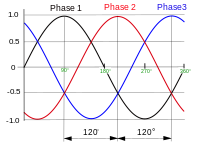
Photo from wikipedia
This paper proposes a novel three-phase transformer-based multilevel inverter (MLI) topology to maximize the output voltage levels for high-power high-voltage applications while reducing component counts as compared to its transformer-based… Click to show full abstract
This paper proposes a novel three-phase transformer-based multilevel inverter (MLI) topology to maximize the output voltage levels for high-power high-voltage applications while reducing component counts as compared to its transformer-based counterparts. The proposed hybrid topology is formed by connecting a three-level T-type module with full H-bridge cells through single-phase transformers. The T-type module is fixed while the full H-bridge cell can be repeated for enlarging the output voltage levels without increasing the voltage stress on switches. Key features of the proposed topology include low part count, capacitor-free, diode-free, voltage boosting, simple control, and modularity. Within the framework, a simple low-frequency pulse width modulation (LFPWM) switching scheme is used to control the output voltage, and the working principle is detailed for seven-, nine-, and N-level operation. The operability and performance of the proposed topology are numerically verified and experimentally validated at different loads. Moreover, its conversion efficiency is experimentally examined. Finally, a comparative study with existing transformer-based MLI circuits is conducted to prove its key merits.
Journal Title: IEEE Access
Year Published: 2022
Link to full text (if available)
Share on Social Media: Sign Up to like & get
recommendations!